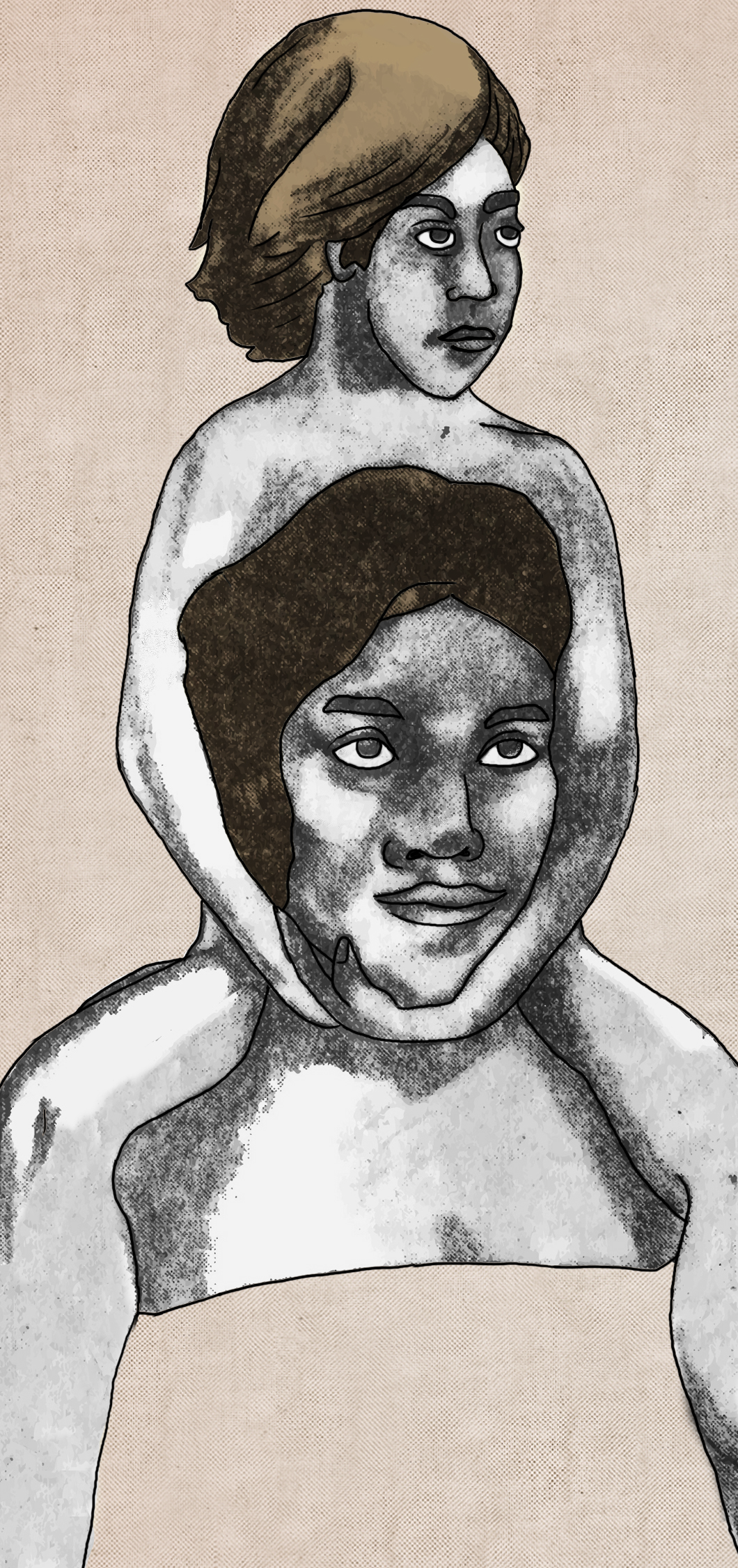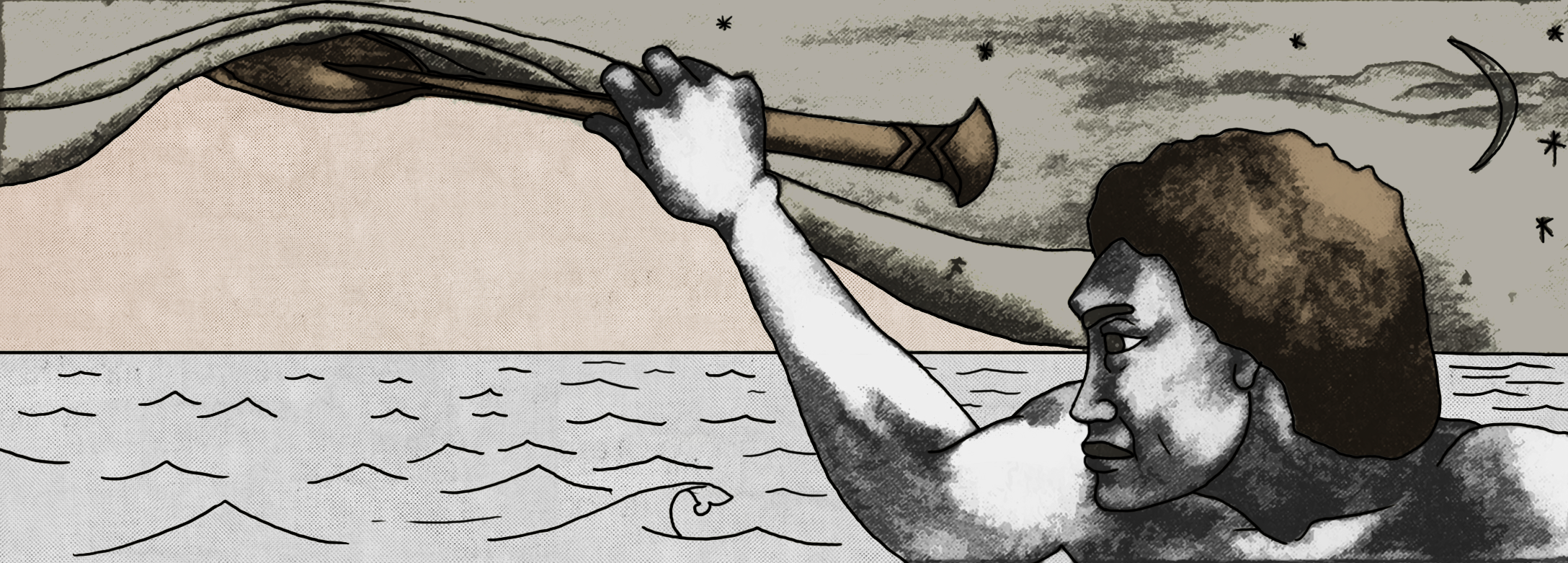
‘aveina atu ‘o ia ‘i le apitāgalu ‘ona ‘auina atu fo’i lea o se toea’ina na te tausia lelei, Sā fa’apea ai ona i’u ‘ina tupu a’e ma ‘avea ma se tama talavou
‘aulelei.’0 le tasi aso, sā lā feiloa’i ai ma se tama’ita’i ma, ‘o le taimi lava na va’aia ai e le tama lea fafine, na ia iloa ai ‘o lona tinā lava lea. Sā ia ta’uina atu lea manatu ‘i ā te ia; peita’i, sā le’i talitonu le tama’ita’i, vaganā ona ‘ua māe’a lelei ‘ona talatalaina atu e le tama le tala i lona ō- laga. Na ‘āmata ai loa ona talitonu ma alofa tele atu le tama’ita’i ‘i lana tama; sā ia si ‘i a’e ma fa’ati ‘eti’e i uiga na maua mai ai e Maui lona igoa, Talaga, ‘o lona uiga,”‘O le ti’eti’e i ona tau’au i aso ta’itasi. ‘0 lea lā ‘ua ta’uta’ua i Sāmoa, ‘o Ti’eti’e i tau’au o Talaga.”Sā tuputupu a’e le tama ‘o Maui Ti’eti’e i Talaga ma ‘avea ai ma tagata matua ma 1e mālosi fa’apea ma lona poto-māsani. ‘0 lona tamā, Ma’eatutala, sā pūlea le ma’ū- maga (fa^ato’aga talo) tele a Māfui’e, se tagata lāpo’a tele na nofo i Pulotu. ‘0 aso ta’itasi ‘i le taeao pō lava, sā alu atu ai le tamā o Maui ma toe fo’i mai i le afiafi pō. ‘E leai se tasi ō le ‘āiga e fōliga na te iloa le mea e malaga āga’i ‘i ai le toea’ina. ‘0 lemāfua’aga 1 ea na tonu ai le manatu o Maui ‘o le’ā na su’e- ina po ‘o fea_e alu atu ‘i ai lona ‘ tamā ma, po ‘o ni ā fo’i ana gāoioiga ‘o lo ‘o fai ai.

__ nofo ai pea lava e ui ‘ina le malie lona tamā. Sā tonu i lona māfaufau ‘o le’ā sā’ili mea ‘uma ‘e uiga i lenei nofo aga lilo.’A ‘o fealualua’i le tama, na taia lana sosogi ‘i se nanamu e uiga ‘ese le manogi. Sā āga’i atu ai ioa ‘i le itu lea e sau ai le nanamu, ma na fa’afua- se’i ‘ona taunu’u ‘i totonu o le umukuka o Māfui’e ma, na ia maua atu ‘i ai se manufata (pua’a) fa’ato’ā māe’a ona fa’avela lelei, fa’apea ma le anoano o talo vela. Sā ia tofotofoina loa nā meataumafa. ‘0 ni mea’ai e uiga’ese le mānaia, ‘o lona manatu ifo lea i lona loto, ‘ai se ā e le fa’apea ai ona sa- unia a mātou talo ma ‘a’ano o manufasi.
‘A ‘o si ona tamā, sā popole pea lava mo lona ola, na mulimuli atu pea ma fa’apea atu: “‘E leai se afi a tātou. Nā ‘o Māfui’e lava e * fa’avela ana mea’ai. ‘A e peita’i, la’u pele Maui, ‘ia ‘e toe fo’i nei ‘a e le’i taunu’u mai Māfui’e ma fasioti ‘i ā te ‘oe.” “Se’i maua mai muamua sa’u afi, ‘ona ‘ou alu ai lea,” ‘o le tali lea a Maui.’0 lea na ia savali (Maui) atu loa ‘i le mūgālafu (Ta’igaafi); peita’i, sā mata’i mai pea nei gāoioiga e le sau’aitagata. Na fa’afuase’i ona ia oso atu ma tauivi loa ma Maui. Peita’i, na pu’eina e Maui ma fusi ona lima, ‘ona lā tauivi ai lava lea pei ni manu-fe’āi mo se taimi ‘umi lava.
Sā 1e’ i fia fa’avaivai se tasi o lā’ua. Na i’u ‘ina maua e Maui le lima o 1e ali’i tino’ese ma mimilo ai lava se’ia o’o ‘ina aue le ali’i ‘i le tTgā.
‘E ui ‘i lea, sā le’i tu’ua ai lava e Maui le lima; na ia saga mimilo mālosi pea se’ia o’o ai ‘ina talosaga atu 1e ali’i tino’ese, ma fa’amolemole ‘ina ‘ia fa’asa’oloto ‘o ia mai_ona māfatiaga. Sa faiatu Maui, ‘e fa’ato’ā mafai ‘ona tatala atu ‘o ia pe ‘ā fai e malie mai lona loto e ‘ave mo ia ni motu- motu mai lana ta’igaafi. Sā malie vave atu ‘i ai le sau’ai. ‘0 le ala lea na maua ai e tagata Sāmoa le ulua’i afi, ma talu mai ai, sā fa’avela meatau- mafa a tagata Sāmoa.
Na mulimuli ane ona ‘avea Maui ma se tagata fōlau ta’uta’ua. ‘0 le talatu’u a Toga e fa’apea, ‘o Togatapu, 1e motu aupito tele o Toga, sā sisi a e i luga e Maui ‘i se mātau na ia maua mai Savai’i.

‘0 se tasi talafa’asolopito e fa’apea, na malaga atu Maui āga’i ‘i le itū i saute^ma ia taunu’u atu ai ‘i le tafatafā’ilagi. ‘A e faimai, ‘e ui ‘i lenā fa’afTtāuli, na le’i fa’afiti ai lava Maui. Na ‘o na tago atu lava ‘o ia i le foe ma lona ‘au malō, ma tete’e mālosi ai ‘i luga le lagi ‘a e alu pea lana malaga. ‘0 ia ‘o le tagata muamua lea na fetaui ma se mauga’aisa ‘o ia fo’i na muamua ona va’ai ‘i ni pua’asami, ni pea (manu) papa’e, ma ni isi lava manu mātagōfie ‘ese’ese.
‘0 1e talatu’u fo’i a Maori e fa’apea, ‘o Maui ‘o le Polenisia muamua lea na tūvae ‘i Niu Sila. ‘0 ia lea, e tusa ‘ona lātou faimai, na vaeluairia ni motu ‘ina ‘ia mafai ‘ona fōlau atu ai ‘i totonu. ‘Ina ‘ia fa’amanatuina ai ‘o ia, ‘ua tā’ua ai e Maori le Motu i Mātū, ‘o “Ika o Maui” ma le Motu i Toga (saute), ‘o “Waka-o-Maui.”
‘0 le tasi motu o Hawai’i e ta’ua fo’i ‘o Maui, ‘e fa’amanatu ai pea lava lenei tagata-fōlau atamai ma le lototele.

Maui is perhaps the most notable of heroes in the Polynesian mythology. He is- at the very least- mischievous, smart, and so beguiling he can win his mother’s heart back with his words, fool his father sufficiently to make him complicit in his plan to steal fire from his grandmother, steal fire, and so daring, cunning, brave, inventive, and accomplished that he appears irresistible throughout Polynesian lore. Maui, a demigod, lived his life here on earth, while, at the same time, traversed the mythological spaces of the world below (the underworld) and the Heavens above. The version prepared by Brother Fred Henry in 1979 notes most of the extensive scholarship about the Samoan Maui mythology. He is also known as Ti’iti’i, and sometimes Ti’eti’e.
Maui was the son of the gods Ma’eatutala and Talaga. Because he was born prematurely, his mother threw him into the foam of the sea, hoping in that way to get rid of the yet unformed child. The gods, however, overruled her rash decision and decreed differently. They first sent some waves to take him ashore, and then sent the older ancestors to nurse him to health and safety. He soon grew into a very beautiful young boy.
One day, Maui met a woman. Immediately he felt sure that she was his true mother. He told her this, knowing he would have to convince her, since, by discarding him in the first place, she would believe it impossible that he could be alive. But it was not long until, after Maui recited the details of his life, his skeptical mother finally believed him. Then, to their mutual delight, she became so fond of him that she carried him day after day on her shoulder and never let him go again.

From this habit, Maui is commonly known in Samoa by the name of Ti’eti’e i Talaga, i.e. riding on (the shoulders of) Talaga.
Once reunited with his mother (sometimes known as Hina), Maui grew into a very strong and skillful young man.
Maui’s most famous adventures surround his father’s work on behalf of Mafui’e. Maui’s father Ma’eatutala was in charge of the taro-plantation owned by the giant Mafui’e who lived in the under-world, owned fire and managed earthquakes. Every day, early in the morning, Maui’s father went away, and returned only after dark. None of the family seemed to know where he went. The always curious Maui found this mystery irresistible. He had to solve it. He determined to find out where his father was going and what he was doing.
One day Maui’s curiosity overcame him, and he was compelled by an irresistible urge to follow his father in secret. After half an hour’s walk, Maui saw his father stopping before a steep hill. Then he heard his father murmuring very strange incantations in the direction of the hill, when suddenly the hill opened to let his father enter. Maui, always fearless, followed him into the mountain, unnoticed by both his father and the mountain itself.
When his father finally became aware of his son’s presence, in fear for Maui’s life, he urged him to go back. “If you do not return to earth”, so he told him, “my master, the giant Mafui’e, will certainly kill you”. But Maui, undaunted, could not be convinced, and remained against his father’s wishes in the underworld, determined to learn about that mysterious place.
Wandering about, he smelled something new and tantalizing. Curious as always, he walked in that direction, and soon came to the kitchen of Mafui’e and there he presently discovered freshly roasted pig and many cooked taros. He tasted both. “What delicious food,” he cried out, “Why don’t we prepare our taro and meat like this!”
His father, who, anxious for Maui’s life, had followed him, begged him saying: “We have no fire. Mafui’e is the only one who can eat cooked food. My dear son Maui, please go back before he comes and kills you.” But Maui resisted, and answered, “Let me first get some fire, and then I’ll go.”
Thereupon he went straight to the fireplace; but the giant, who had already been watching him for some time, jumped up and went for the intruder. But Maui caught his two arms and then they wrestled like tigers for a long time.
Neither wanted to give in. Finally Maui contrived to twist the giant’s arm in such a frightful manner that he roared with pain. The boy, however, did not let loose; he even twisted harder and harder until the giant begged him to stop torturing him. Maui said that he was quite willing to let him go, but only in exchange for some fire to take home. The giant Mafui’e, in his agony, finally agreed. In this way the Samoans got their first fire, and ever since, they have enjoyed cooked food.
Later, Maui became a famous sailor. The Tongan tradition relates that Tongatabu, the largest island of the group, had been pulled up by Maui with a hook he obtained from Savai’i.

Another tradition tells us that Maui sailed so far towards the south, that he reached the end of the horizon where the sky met the ocean. But even that challenge presented no difficulty to a man like Maui. He simply took his paddle and with its heavy handle he pushed the sky upwards until high enough so that he could pass under the horizon and sail on.
Maui was the first sailor who met with icebergs, and the first who saw seals white bears, and many other wonderful animals.
The Maori tradition relates that Maui was the first Polynesian who landed in New Zealand. It was he, so they say, who cut the island into two islands in order to sail across the sea between them, rather than make the journey around. In memory of him, the Maori called North Island Ika-o Maui” and the south Island “Waka-o-Maui”. One of the Hawaiian Islands is also called Maui in honour of this clever and daring sailor.
For More about Maui, the reader is referred to W.D. Westerfield, The Legends of Maui, (1920) at www.sacred texts.com.
Comments are closed here.